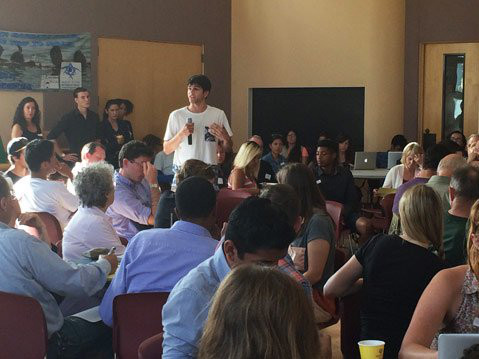Isla Vista Finances Scrutinized
Study Looks at Four Options, Including Community Services District

A study of the dollars and cents involved in Isla Vista’s governing options was unveiled to the small community at a well-attended Wednesday meeting at Santa Barbara Hillel. The event just happened to coincide with Governor Jerry Brown’s signing of AB 3, which effectively puts an item on the 2016 ballot that allows Isla Vista voters to decide whether or not to establish a community service district. The bill’s sponsor, Assemblymember Das Williams, said he decided not to attend the Wednesday meeting to keep politics out of it and that he was “ecstatic” that Brown had signed the bill.
As a practical matter, Brown’s action makes a community service district the most likely out of the four options scrutinized for financial viability; the others were a municipal advisory council, an area planning commission, and, most desired by activists, cityhood.
As it turned out, the $70,000 fiscal study, completed by Economic & Planning Systems (EPS) with Berkson Associates, came remarkably close to longtime education advocate Lanny Ebenstein’s back-of-the-napkin calculations of the amount of special tax revenues a community service district could bring in. The first of its kind in four decades, the study was paid for by the Fund for Santa Barbara, UCSB, Santa Barbara City College, the county, and others with a vested interest in the place.
The study found a 5-8 percent utility users tax — on trash, water, sewer, and others — could generate between $320,000 and $512,000 each year. After costs covering a general manager, part-time administrative assistant, and office supplies, remaining funds could be as little as $63,000 or as much as $255,000. Over the summer, UCSB pledged to pay $200,000 each year for seven years to the district if established.
That money could pay for a number of amenities, including tenant-landlord mediation, additional police officers, building or code enforcement, and public works projects. Many of the services, at least initially, could be contracted out. The report also suggests a menu of benefits, including a half-time grant writer, who could pursue supplementary money for the district.
Currently, the county provides $5 million per year for municipal services in the so-called Isla Vista box, where just over 15,000 people live. About 8,000 students reside on campus, or about 40 percent of UCSB’s student body, according to the study. UCSB chips in funds for sheriff, fire, and medical services as well as alcohol and drug and counseling programs.
According to budgets posted online, UCSB’s Associated Students (AS) received $6.56 million last year in student fees, excluding money designated for the university for items such as Student Health or Arts & Lectures. That AS money provided a tenants union, KCSB radio station, legal resource center, Pardall Center, and many others. The amount AS pours into Isla Vista was not available at the time of the report’s publication.
The Isla Vista Recreation and Park District (IVRPD), which brings in $1.3 million per year from property and special bedroom taxes, maintains more than 70 acres of parks and supports children’s recreation programs. About 72 percent of its revenue goes to salaries and benefits for its 10 employees, according to county records.
Per AB 3, the park district would remain separate from the community services district should voters approve its creation next November. Where park district supporters laud IVRPD’s stability and good work for more than 40 years, others argue consolidating the two entities would be efficient and cost effective.
If long-term activists had their druthers, Isla Vista would be a city, and a number of attempts to establish one were made over past decades. The report found that revenues are $3.1 million short of the funds necessary to achieve cityhood, which would cost about $8.4 million. To fund this shortfall, the new city could put new taxes before the voters, the report notes. The county could transfer its property tax base to the city. (The fine print notes other options exist, such as annexation by Goleta or Santa Barbara, but could not be pursued by Isla Vista voters.)
On the other end of the spectrum, a municipal advisory council or an area planning commission could be formed by the Board of Supervisors and would be relatively inexpensive.
On Wednesday, UCSB history professor Alice O’Connor read a number of audience questions, some that consultant EPS’s representatives could not answer. For instance, will the formation of a governing mechanism increase rents? Common knowledge, Richard Berkson noted, is that rents will go as high as people will pay for them. “It all depends on the elasticity,” he said.
The reason a utility users tax is written into AB 3, Williams has stated in the past, is to put the burden of extra taxes on both property owners and renters.
One person in the audience said it seemed as if there were not enough property owners making decisions about self-governance options. With that, another person sitting in the front row swung back, “Whose fault is that?”
The controversial issue of UCSB acquiring properties for student housing in Isla Vista also came up. Apartment buildings owned by the university will eventually be taken off the county tax rolls. That hasn’t happened yet for the three Tropicana properties, UCSB officials say, and existing agreements are still in place this school year.
As for AB 3, meetings will continue to take place on Tuesday evenings at the Isla Vista clinic building.



